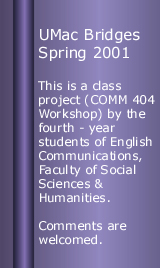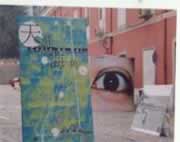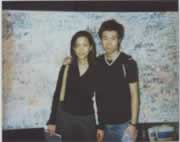




Street museum - back to Macau's old days
By Bovane Lo
The Visible City -- an activity that takes you to trace back Macau's fascinating history -- requires a full co-ordination of your feet, eyes, ears, heart and mind.
On March 17 and 18, the Association Audio Visual CUT held an activity called "The Visible City." I had been told that the activities would include video shows, museum tours, music lectures and lots of other programmes. With a great curiosity, I decided to go and have a look.
At 2:00pm on March 18, my friends and I arrived at the first stop - St Francisco Garden and got our "passports" to the Visible City. The passport was a booklet with the introduction to the activities, the brief history of Macau and an incomplete map of old Macau.
As the "passport" holders, we were required to tour the "The Visible City" following a route which covered various districts and scenic spots enclosed by the old city wall of Macau. There were six stops along the route: the old Barracks of St Franciso where the city wall used to start; the city walls of Macau; the Birds District; St Lazaurs; the alley area between Patio do Espinho and the Patane district and the Monte Fortress.
We had to get the map stamped at each stop, each stamp indicating a historical place in the old enclave. So after going through the six stops, the map would be completed and we could also get a "secret present."
We started at the first stop, the old Barracks of St Francisco. It was reconstructed from the deserted convent of St Fancisco at the end of the 18th century. The St Francisco Fortress was originally built in 1622 to imprison the defeated Dutch when they made a failed invasion of Macau. The bay area in front of the St Francisco Barracks was one of the major ports over 100 years ago.
From here, we were walking towards the second stop, the city walls of Macau. Built more than 300 years ago, the city wall used to consist of two sections, one in the north and the other in the south. Macau was then divided into two halves. The one to the south of the wall, known as the Catholic Town, was mainly populated by the Portuguese. The northern one was a residential area for Chinese and thus was called the Chinese Town. Most parts of the walls were torn down in the 16th century.
As we were heading towards the third stop, there were TV sets on the way displaying video programmes produced by directors from Macau, Hong Kong, Hangzhou, Shanghai and Taiwan. Most of the videos were about their own cities and some had won awards in competitions. We walked while enjoying the videos until we came to the Birds District, the third stop. The district was named because it was situated in the early inner boundary of the city wall and was densely covered by woods which provided shelters to many species of birds. As we were coming down the stairs, to my surprise, I saw people dressed as they were in the 50's and 60's. Actually they were actors and actresses who were going to perform the drama "The Love Story of Well." Immediately, we sat down on the stairs like other audience and watched their performance! Through the performance, we came to know about the life of the people at that time.
After the play, we started our trip again to the fourth stop - St Lazarus. It was located in the vicinity of the St Lazarus Church in Rua Nova de S Lazarus. It was at the outer boundary of the city wall and was such a remote district at the time that it was where lepers lived and were treated. In 1818, a chapel was built because several Chinese catholic families moved to live in the adjacent area and feared to mix with the lepers. The chapel was later reconstructed in 1886 and became the St Lazarus Church.
Next to St Lazarus Church was the Old Ladies' Home. When we arrived, Gay Singers -- a group of singers formed by eight members from Hong Kong -- were performing. Although they sang without any accompaniment of instrument, they sang different voices and imitated different sounds. There I saw many friends. They were all amazed at the uniqueness of this activity. It has inspired us in a variety of ways, for example, how we would feel about music and art. There were many places in Macau that we had never been to and never thought of their historical significance. Now we could come to know Macau in its old days. There were also many other performances such as piano solo and drama, but due to limited time, we could not enjoy them all.
At 5:00pm, we left the Old Ladies' Home and continued our trip to next stops. The distance between the fourth and fifth stops was the longest. There were many sub-stops with at least one person who gave us tips on the following route. We felt very tired, but we had to finish the journey before 6:00pm, which was the closing time of the event. Several times we thought of giving up, but the guides at each sub-stop told us that we were near to the fifth stop. We walked through lots of alleys which were just like a maze. It took us more than half an hour to walk through the Patane District to Jardim de Luis de Camoes.
There are four alleys in Patio do Espinho which were built against an earth wall. They formed a part of Sam Pa Mum of the Catholic town. In the 17th century, Japan prosecuted the believers of God in the country and a large number of Catholics fled to Macau and stayed at Patio do Espinho and the surrounding areas. The largest well of Macau was built here by the Japanese Catholics.
As we were walking along through alleys, there were banners such as "Keep on Trying Hard!" and "Do you Have Fun?" to encourage the visitors.
Finally we came to the fifth stop and we were surprised to find out that it was located near the Luis de Camoes Garden, where we had already walked through at the very beginning of the fifth stop. However, this did not discouraged us and we started to approach to the sixth stop -- the Monte Fortress.
Built by the Portuguese settlers at the hilltop of Pui Shan in 1616, it was the largest fortress in Macau to protect local inhabitants and the missionaries of the St Paul's Church from patrols of pirates in the waters nearby. In 1622, about 1,000 Dutch invaded Macau from the Dog Ring and were driven away by cannon balls fired from the fortress.
At last we arrived at the last stop.
Although we were nearly exhausted,
we felt that it was worth it. In front of the Museum of Macau, we signed
our names and got the "secret present" we had been yearning for -- that
was a secret person who took a secret photo for us!

Welcome to the first stop of The Visible City.

This is the "secret
present" we've received .